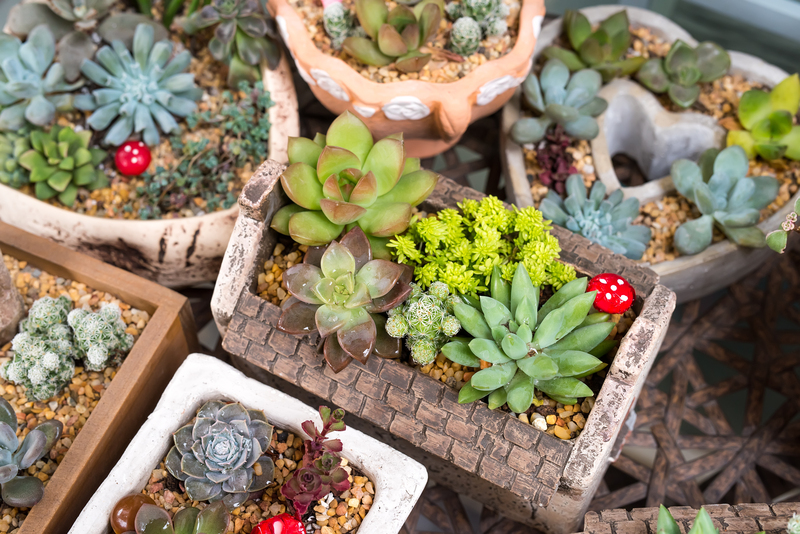Crafting a Weather-Resilient Garden Environment
Posted on 29/06/2025
Crafting a Weather-Resilient Garden Environment: Your Guide to Resilient Gardening
As global weather patterns become increasingly unpredictable, gardeners everywhere are discovering just how important it is to create a weather-resilient garden environment. Whether you're new to gardening or a seasoned pro, understanding how to adapt your green space to withstand fluctuating weather conditions is vital. This comprehensive guide will walk you through expert techniques, strategic plant selection, and thoughtful design principles to help you craft a garden that thrives--no matter what the forecast brings.
Why a Weather-Resilient Garden Is Essential
Weather-resilient gardens provide more than just a beautiful oasis. They protect your plants from the extremes of heat, cold, drought, and storms. By building resilience into your garden, you also reduce maintenance, conserve resources, and contribute to local biodiversity. Let's delve into the benefits:
- Protects plants from harsh climatic conditions
- Reduces the need for excessive watering or intervention
- Supports local wildlife such as pollinators and birds
- Minimizes soil erosion and nutrient loss

Understanding Your Garden's Microclimate
Every garden has a unique microclimate. By recognizing yours, you can make smarter decisions for a more weather-resilient garden environment. Key microclimate factors include:
- Sun exposure: Are areas of your yard sunny, shady, or a mix of both?
- Wind patterns: Notice the direction and strength of prevailing winds.
- Temperature fluctuations: Some garden spots might be warmer or cooler than others.
- Soil drainage: Identify spots where water pools after rain or dries out quickly.
Tip: Keep a garden diary for a season to observe temperature, sunlight, shade, and moisture levels in different locations. Armed with this knowledge, you'll be better able to select spots for various plants and structures, ensuring your resilient garden flourishes.
Designing for Resilience: Practical Tips and Techniques
1. Enhance Soil Health
Healthy soil is the backbone of a weather-tough garden. To boost soil resilience:
- Add organic matter like compost or well-rotted manure
- Mulch regularly to regulate temperature and retain moisture
- Avoid chemical fertilizers that can reduce beneficial microbial life
Soil rich in organic materials absorbs water effectively, provides plants with essential nutrients, and buffers temperature extremes. This strong foundation supports a true weather-adaptive garden atmosphere.
2. Choose Weather-Resistant Plants
Plant selection is crucial. Opt for drought-tolerant, native, or weather-hardy plants adapted to your local climate. Some resilient plant options include:
- Lavender (Lavandula spp.) - Drought-tolerant and fragrant, ideal for sunny spots
- Black-eyed Susan (Rudbeckia hirta) - Resilient to both drought and heavy rainfall
- Switchgrass (Panicum virgatum) - Provides windbreaks and erosion control
- Yarrow (Achillea millefolium) - Hardy, drought-tolerant, and beneficial for pollinators
- Sedum & succulents - Store water and withstand long dry periods
Native plants are especially valuable because they've evolved to thrive in your specific weather patterns, often requiring less water, fertilizer, and care.
3. Smart Garden Zoning
Divide your space into zones based on climate exposures and plant needs:
- Windbreak zones (using tall grasses, shrubs, or fencing on exposed sides)
- Rain gardens (to manage stormwater and prevent flooding)
- Dry gardens (with gravel, sand, or rock mulch for drought-prone areas)
- Shade gardens (for delicate or moisture-loving plants on the cooler side of structures/trees)
This approach ensures that each plant receives the care and protection best suited to its needs, enhancing your weather-proof garden design efforts.
4. Water Management Strategies
Water is a vital resource, especially as weather extremes increase the risk of both drought and flooding. Effective strategies include:
- Rainwater harvesting via barrels, cisterns, or rain chains
- Drip irrigation systems for efficient, targeted watering
- Bioswales and French drains to direct stormwater away from plant roots
- Mulching to conserve soil moisture and lower evaporation rates
By redirecting and conserving water, you'll build a garden environment that can withstand periods of both dryness and excess rainfall.
5. Build Wind and Storm Protection
Strong winds can physically damage plants and dry out soil fast. Create natural windbreaks by:
- Planting dense, tall shrubs or trees along wind-prone borders
- Using permeable fences or trellises that slow, not block, strongest gusts
- Installing sturdy garden structures to support vulnerable plants
- Grouping plants closely to protect one another from forceful winds
These measures provide a buffer in your garden's weather-resilience plan, ensuring delicate plants stay safe during storms.
6. Plan for Heatwaves and Cold Snaps
Temperature extremes can catch even the most careful gardener off guard. Protect your plants by:
- Installing shade cloths or pergolas over heat-sensitive species
- Using a thick layer of mulch in summer and winter to stabilize soil temperatures
- Covering plants with fleece or protective fabric during unexpected frost
- Grouping pots and containers together to create a micro-insulation effect
Being proactive will help your climate-adaptive garden rebound after temperature stress events.
7. Implement Resilient Maintenance Practices
Your maintenance routine should support resilience:
- Prune regularly to remove dead or diseased growth
- Weed vigilantly to reduce resource competition
- Monitor for pests--especially after weather events--which can stress weakened plants
- Add soil amendments as needed, based on periodic testing
Consistent care ensures your garden is always ready to cope with new challenges.
The Role of Biodiversity in Weather-Resilient Garden Design
Incorporating a diverse range of species is key to building a truly weather-hardy garden environment. Biodiversity creates built-in checks and balances:
- Encourages beneficial insects and natural pollinators
- Reduces disease and pest outbreaks by limiting monoculture
- Increases adaptability--if one plant fails, others may thrive
- Improves soil health through varied root systems and nutrient profiles
Ideas for Boosting Garden Biodiversity
- Mix flowering perennials with annuals and shrubs
- Designate a wildflower or meadow patch for pollinators
- Add a small pond or bird bath for wildlife hydration
- Use companion planting to deter pests and enhance plant health
This strategy not only beautifies your space but ensures a truly resilient garden ecosystem that can handle shifting weather patterns.
Adapting to Localized Weather Challenges
Every gardener faces unique challenges, depending on their region and climate zone. Here's how to fine-tune your resilient garden for specific weather threats:
For Drought-Prone Areas:
- Favor succulents, deep-rooted grasses, and Mediterranean herbs
- Choose porous mulch like gravel that retains little moisture, preventing rot
- Group plants with similar water needs for efficient irrigation
Where Heavy Rainfall or Flooding Occurs:
- Install raised beds to keep roots above standing water
- Use bog-tolerant plants such as astilbe or Japanese iris
- Incorporate rain gardens or swales for water absorption and filtration
Facing Frequent Frost or Cold Snaps:
- Grow cold-hardy perennials and shrubs such as juniper or hellebore
- Apply winter mulch and use protective covers on vulnerable species
- Site sensitive plants against warm south-facing walls

Sustainable Practices for Lifelong Garden Resilience
Sustainability is the secret behind every long-term, weather-adaptive garden. Small, eco-conscious actions contribute greatly to your garden's endurance and vitality:
- Compost kitchen scraps to enrich soil and reduce waste
- Choose local and recycled materials for garden structures
- Limit pesticide use--favor organic, integrated pest management techniques
- Improve energy efficiency with solar lighting and drip irrigation.
Merging resilience and sustainability not only improves your green space but also benefits the wider community and the planet.
Final Words: Reap the Rewards of a Weather-Resilient Garden
Creating a weather-resilient garden environment involves thoughtful planning, regular care, and a willingness to adapt. The result is a sanctuary that flourishes despite what Mother Nature may bring.
By implementing the strategies outlined in this guide--from choosing robust plants and improving soil, to managing water wisely and promoting biodiversity--you will ensure that your garden remains beautiful, productive, and climate-resilient for years to come.
Ready to start crafting your own weather-resilient oasis? Tap into these expert tips, observe your unique microclimate, and layer in sustainable practices. You'll be rewarded with a thriving, weather-resistant haven that stands strong through storms, sun, and everything in between.
Additional Resources:
- Adapting Gardens to Climate Change (RHS)
- How to Make Your Garden Weather-Resilient (Gardener's World)
Begin crafting your weather-resilient garden today and enjoy an outdoor space that weathers every season with grace and abundance.

